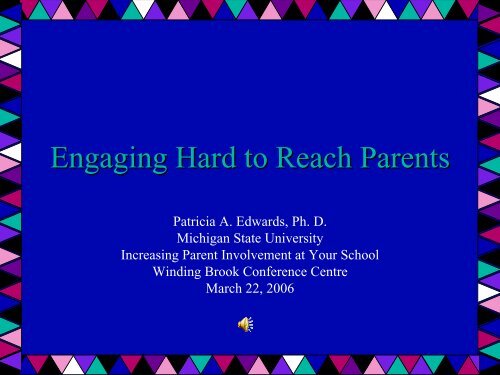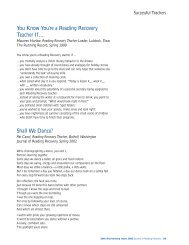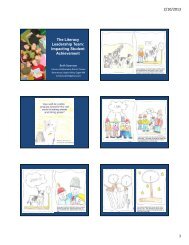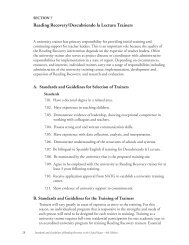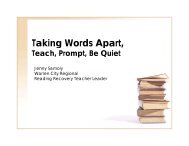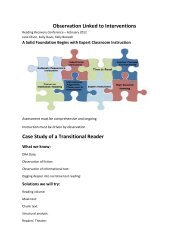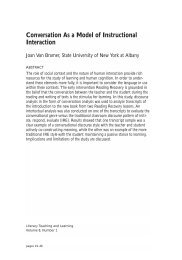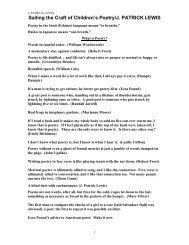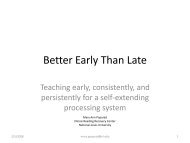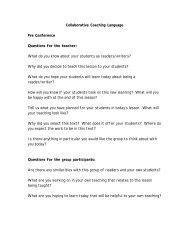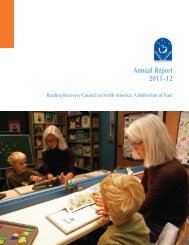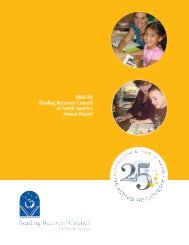Engaging Hard to Reach Parents - Reading Recovery Council of ...
Engaging Hard to Reach Parents - Reading Recovery Council of ...
Engaging Hard to Reach Parents - Reading Recovery Council of ...
You also want an ePaper? Increase the reach of your titles
YUMPU automatically turns print PDFs into web optimized ePapers that Google loves.
<strong>Engaging</strong> <strong>Hard</strong> <strong>to</strong> <strong>Reach</strong> <strong>Parents</strong><br />
Patricia A. Edwards, Ph. D.<br />
Michigan State University<br />
Increasing Parent Involvement at Your School<br />
Winding Brook Conference Centre<br />
March 22, 2006
The information in this PowerPoint<br />
presentation is copyrighted.<br />
Edwards, P. A. with Pleasants, H. M., & Franklin, S.<br />
H. (1999). A path <strong>to</strong> follow: Learning <strong>to</strong> listen <strong>to</strong><br />
parents. Portsmouth, NH: Heinemann.<br />
Edwards, P. A. (2004). Children’s literacy<br />
development: Making it happen through school,<br />
family, and community involvement. Bos<strong>to</strong>n: Allyn<br />
and Bacon.
A Path <strong>to</strong> Follow: Learning <strong>to</strong> Listen <strong>to</strong> <strong>Parents</strong> (1999)
Children’s s Literacy Development: Making It Happen Through<br />
School, Family, and Community Involvement (2004)
Objectives<br />
• The purpose <strong>of</strong> this presentation is <strong>to</strong>:<br />
– Identify characteristics <strong>of</strong> those families who<br />
are hard <strong>to</strong> reach<br />
– Help participants <strong>to</strong> better reach those families<br />
who are more difficult <strong>to</strong> reach
<strong>Parents</strong> Behaving Badly—Nancy Gibbs<br />
February 21, 2005
• Not all parents are angels. All are<br />
individuals—accept the real person in front<br />
<strong>of</strong> you. Be prepared <strong>to</strong> work where each<br />
one is. The way they were treated in the<br />
past, and the way the present is bearing<br />
down on them makes some parents appear<br />
negative. Get past the wall with your<br />
acceptance and sincerity (Peterson, 1982).
The <strong>Hard</strong> To <strong>Reach</strong> Parent: Old<br />
Challenges, New Insights<br />
• Rule #1: Believe in the importance <strong>of</strong> parent involvement<br />
• Rule #2: Embody an ethnic <strong>of</strong> caring<br />
• Rule #3: Disregard “hard-<strong>to</strong>-reach stereotypes<br />
– Believing that all children from non-middle-class families are<br />
troublemakers.<br />
– Believing that it is alright <strong>to</strong> contact families only when a child is<br />
in trouble.<br />
– Regarding poor families as deficient, seeing only their problems<br />
and not their strengths.<br />
– Believing that the problems <strong>of</strong> “hard-<strong>to</strong>-reach” families are the<br />
fault <strong>of</strong> the families themselves (Davies, 1988).
• Rule #4: Develop high expectations for all<br />
parents<br />
• Rule #5: Conceptualize the role <strong>of</strong> parents
Volunteers
Helping with Homework
<strong>Parents</strong> Sitting on <strong>Council</strong>s<br />
and Committees
Participating in the Decisions<br />
and Operation <strong>of</strong> Schools
Specta<strong>to</strong>rs
Band Boosters
Spaghetti Dinners
Ice Cream Socials
Collabora<strong>to</strong>rs/Problem Solvers
Participating in Bake Sales and Fairs <strong>to</strong><br />
Raise Funds for the Band Uniforms or<br />
School Computers
Adversaries
Advisors and/or Co-decision<br />
Makers
Serving as Classroom Aids
Accompanying a Class on an<br />
Outing
• Rule #6: Actualize the role <strong>of</strong> educa<strong>to</strong>r (i.e.,<br />
principal, classroom teachers).<br />
• Rule #7: Be willing <strong>to</strong> address personal concerns<br />
– Uncertainty about how <strong>to</strong> involve parents, and at the<br />
same time maintain the teacher’s role <strong>of</strong> expert.<br />
– Fear that parents will try go take over teaching<br />
responsibilities and not follow the teacher’s instructions<br />
and school regulations.<br />
– Worry that parent involvement takes <strong>to</strong>o much planning<br />
(Becher, 1984)
• Rule #8: Be willing <strong>to</strong> work <strong>to</strong> improve<br />
parent involvement
Breaking Down Barriers <strong>to</strong> Family<br />
Involvement in Schools<br />
• More staff time <strong>to</strong> communicate with<br />
families<br />
• Accommodating parent schedules,<br />
transportation, and child care needs.<br />
• Resources for learning at home
Three New Directions for Working<br />
with Families and Children<br />
1<br />
Parent S<strong>to</strong>ries<br />
Demographic Pr<strong>of</strong>ile<br />
2<br />
3<br />
Scope and Sequence <strong>of</strong><br />
Parent Involvement
Schools Are At The<br />
Crossroads<br />
Yesterday’s<br />
Traditions<br />
Today’s<br />
Demographics<br />
Tomorrow’s<br />
Technologies<br />
This three-way<br />
intersection is, at<br />
this time, a<br />
hazardous crossing.<br />
We are seeing red<br />
<strong>to</strong> s<strong>to</strong>p and head<br />
back <strong>to</strong>ward<br />
traditional<br />
curriculum designs,<br />
We are seeing<br />
yellow signals <strong>of</strong><br />
caution about<br />
innovative<br />
curriculum. We are<br />
getting green<br />
signals <strong>to</strong> go quickly<br />
in many directions<br />
with technological<br />
advances.<br />
New Direction <strong>to</strong> Improve<br />
Education<br />
Parent<br />
Involvement
National Reports
A Nation At Risk: The Imperative For<br />
Educational Reform (1983)
Becoming a Nation <strong>of</strong> Readers: The Report <strong>of</strong><br />
the Commission on <strong>Reading</strong> (1984)
One-Third Of A Nation: A Report <strong>of</strong> the Commission on<br />
Minority Participation in Education and American Life<br />
(1988)
Some His<strong>to</strong>rical Trends<br />
• America <strong>Reading</strong> Corps (President Clin<strong>to</strong>n,<br />
1997)<br />
• No Child Left Behind Act <strong>of</strong> 2001<br />
(President Bush)<br />
– <strong>Reading</strong> First<br />
– Early <strong>Reading</strong> First
No Child Left Behind Act <strong>of</strong> 2001
No Child Left Behind: Now What Do We Need<br />
<strong>to</strong> Do <strong>to</strong> be Culturally Responsive?<br />
• Consider Own Attitudes, Biases and Assumptions<br />
• Value Children’s Language<br />
• Recognize that the Culture <strong>of</strong> the School and the Culture <strong>of</strong><br />
the Child’s Family May Not Be Well Synchronized<br />
• Recognize the Cultural Values Children Bring <strong>to</strong> School<br />
• Consider the Importance <strong>of</strong> Code Switching Among<br />
African American Children
No Child Left Behind: Now What Do We Need<br />
<strong>to</strong> Do <strong>to</strong> be Culturally Responsive?<br />
• Incorporate African Children’s Need for<br />
Multisensory Stimulation in<strong>to</strong> Pedagogical Styles<br />
• Provide Culturally Relevant Instructional<br />
Materials<br />
• Affirm Students’ Cultural Identity with Power-<br />
Enhancing Confidence Builders <strong>to</strong> Enable Their<br />
Successful Development<br />
• Promote Family Involvement and Community<br />
Partnerships
President Bill Clin<strong>to</strong>n—State <strong>of</strong><br />
the Union Address<br />
• “<strong>Parents</strong> who know their children’s teachers<br />
and help with the homework and teach their<br />
kids right from wrong—these parents can<br />
make all the difference.”
• There is remarkable consensus among<br />
educa<strong>to</strong>rs, parents, and the general public<br />
that children will learn more and schools<br />
will improve if we can get parents <strong>to</strong> do a<br />
better job <strong>of</strong> supporting their children’s<br />
schooling (Espinosa, 1995)
• Epstein (1992, p. 1141) has summarized the<br />
research on parent involvement as<br />
suggesting “that students at all grade levels<br />
do better academic work and have more<br />
positive school attitudes, higher aspirations,<br />
and other positive behaviors if they have<br />
parents who are aware, knowledgeable,<br />
encouraging, and involved.”
“Killer Phrases” Used Often Without Thinking,<br />
That Can S<strong>to</strong>p Parent Involvement Initiatives<br />
• Some <strong>of</strong> the phrases that have been used are as<br />
follows:<br />
• A good idea, but…<br />
• The superintendent won’t go for it.<br />
• Against policy.<br />
• All right, in theory.<br />
• We have been doing it this way for a long time,<br />
and it works.<br />
• Source:Henderson, Marburger, & Ooms (1986),<br />
p. 67
“Killer Phrases” Used Often Without Thinking,<br />
That Can S<strong>to</strong>p Parent Involvement Initiatives<br />
• Be practical.<br />
• Why hasn’t someone suggested it before, if it’s a<br />
good idea?<br />
• Costs <strong>to</strong>o much.<br />
• Ahead <strong>of</strong> the times.<br />
• Don’t start anything yet.<br />
• Let’s discuss it.<br />
• Source:Henderson, Marburger, & Ooms (1986),<br />
p. 67
“Killer Phrases” Used Often Without Thinking,<br />
That Can S<strong>to</strong>p Parent Involvement Initiatives<br />
• It needs more study.<br />
• Let’s form a committee.<br />
• Let’s make a survey first.<br />
• We’ve never done it that way.<br />
• Let’s sit on it for awhile.<br />
• That’s not our problem.<br />
• Source:Henderson, Marburger, & Ooms (1986),<br />
p. 67
Reasons for the Limited Participation <strong>of</strong> Families<br />
in Life Inside School and the Overall Lack <strong>of</strong><br />
Commitment <strong>to</strong> Parent Involvement<br />
• The ill-defined nature <strong>of</strong> parent involvement<br />
• The ambiguous nature <strong>of</strong> teacher expectations for parents<br />
• Narrow views <strong>of</strong> school-family connections<br />
• The lack <strong>of</strong> appropriate structures and strategies for<br />
involving parents<br />
• Teachers’ perceptions <strong>of</strong> parents and communities<br />
Edwards (2004)
Reasons for the Limited Participation <strong>of</strong> Families<br />
in Life Inside School and the Overall Lack <strong>of</strong><br />
Commitment <strong>to</strong> Parent Involvement<br />
• A his<strong>to</strong>ry <strong>of</strong> distrust in family-school interactions<br />
• <strong>Parents</strong>’ sense <strong>of</strong> inadequacy and powerlessness in schools<br />
• The changing nature <strong>of</strong> parents’ roles in children’s lives<br />
• An exclusion <strong>of</strong> parents from activities within schools<br />
reflective <strong>of</strong> parents’ social class, race, and ethnicity<br />
Edwards (2004)
• <strong>Parents</strong> differ in their perceptions and<br />
conceptions about school and the schooling<br />
process.
Schools Need <strong>to</strong> Determine<br />
• What activities parents feel capable <strong>of</strong> doing<br />
• What activities parents are willing <strong>to</strong> do<br />
• What activities parents feel responsible for<br />
fulfilling
• Gathering information <strong>of</strong> this nature could<br />
possibly build better home-school<br />
connections between the school and the<br />
wider variety <strong>of</strong> parent groups.
Schools are communicating with a variety <strong>of</strong> parent<br />
groups<br />
• Unwed teenage mothers<br />
• Two-parent homeless families<br />
• Single-parent families<br />
• Stepfamilies<br />
• Working mothers<br />
• Foster families<br />
• Grandparents<br />
• Families living in rural poverty
Schools are communicating with a variety <strong>of</strong> parent<br />
groups<br />
• Migrant families<br />
• Two-parent families<br />
• Low-literate parents<br />
• Culturally diverse parent<br />
groups (i.e., Native<br />
Americans, African<br />
Americans, etc.)<br />
• Extended, reconstituted or<br />
blended families<br />
• Unemployed parents
Hispanic Parent Involvement<br />
(Nicolau & Ramos, 1990, p. 9)<br />
• Personal Touch. It is crucial <strong>to</strong> use face-<strong>to</strong>-face<br />
communication in the Hispanic parent’s primary language<br />
when first making contact. Written flyers or articles sent<br />
home have proven <strong>to</strong> be ineffective even when written in<br />
Spanish. It may also take several personal meetings before<br />
the parents gain sufficient trust <strong>to</strong> actively participate.<br />
Home visits are a particularly good way <strong>to</strong> begin <strong>to</strong><br />
develop rapport.<br />
• Non-Judgmental Communication. In order <strong>to</strong> gain the trust<br />
and confidence <strong>of</strong> Hispanic parents, teachers must avoid<br />
making them feel they are <strong>to</strong> blame or are doing something<br />
wrong. <strong>Parents</strong> need <strong>to</strong> supported for their strengths, not<br />
judged for perceived failings.
.<br />
• Perseverance in Maintaining Involvement. To keep Hispanic parents<br />
actively engaged, activities planned must respond <strong>to</strong> a real need or<br />
concern <strong>of</strong> the parents. Teachers should have a good idea about what<br />
parents will get out <strong>of</strong> each meeting and how the meeting will help<br />
them in their role as parents.<br />
• Bilingual Support. All communication with Hispanic parents, written<br />
and oral, must be in Spanish and English. Many programs report that<br />
having bicultural and bilingual staff helps promote trust (Espinosa &<br />
Lesar, 1994).<br />
• Strong Leadership and Administrative Support. Flexible policies, a<br />
welcoming environment, and a collegial atmosphere all require<br />
administrative leadership and support. As with other educational<br />
projects or practices that require innovation and adaptation, the efforts<br />
<strong>of</strong> teachers alone cannot bring success <strong>to</strong> parent involvement projects.<br />
Principals must also be committed <strong>to</strong> project goals.
• Staff Development Focused on Hispanic Culture. All staff<br />
must understand the key features <strong>of</strong> Hispanic and its<br />
impact on their students’ behavior and learning styles. It is<br />
the educa<strong>to</strong>r’s obligation <strong>to</strong> learn as much about the<br />
children and their culture and background as possible.<br />
• Community Outreach. Many Hispanic families could<br />
benefit from family literacy programs, vocational training.<br />
ESL programs, improved medical and dental services, and<br />
other community-based social services. A school can<br />
serve as a resource and referral agency <strong>to</strong> support the<br />
overall strength and stability <strong>of</strong> the families.
Migrant Family Involvement Strategies<br />
• Opportunities for migrant student success can be nurtured through<br />
family involvement activities that are sensitive <strong>to</strong> their mobile way <strong>of</strong><br />
life and culture (Whitaker, Salend, & Guiterrez, 1997; Romo, 1999;<br />
Murray & Velazques, 2000).<br />
– Bilingual community liaisons can help bridge language and cultural<br />
differences between home and school (i.e., they can train parents <strong>to</strong><br />
reinforce education concepts in the native language and/or English).<br />
– Child care, transportation, evening and weekend activities, and<br />
refreshments can increase the likelihood <strong>of</strong> migrant parent participation.<br />
– Curriculum that reflects the culture, values, interests, experiences, and<br />
concerns <strong>of</strong> the migrant family can enhance learning—parents can more<br />
easily relate <strong>to</strong> such “homework” and will be more inclined <strong>to</strong> help their<br />
child with subjects that affirm their experiences (also increasing their<br />
confidence and self-esteem).
– Flexible instructional programming that allows students <strong>to</strong> drop out<br />
<strong>of</strong> school <strong>to</strong> work or take care <strong>of</strong> family responsibilities and that<br />
allows them <strong>to</strong> return and pick up their academic work without<br />
penalties can increase migrant student success.<br />
– Multiple, coordinated “second-chance” opportunities for education<br />
and training-at work sites, community centers, churches, and<br />
school sites—can be made available for both student and families.<br />
– Distance learning efforts in public computer centers can provide<br />
migrant students and their families with continuous access <strong>to</strong> online<br />
links <strong>to</strong> college and ESL courses (e.g., Kentucky Migrant<br />
Technology Project: http://www.migrant.org).<br />
– Partnerships with the agricultural industry can help potential<br />
collaborative activities that allow schools <strong>to</strong> tap in<strong>to</strong> parents’<br />
knowledge, skills, and talents through “flex time,” (i.e., allowing<br />
parents <strong>to</strong> attend school activities during work hours).
– Parent-teacher conferences can give migrant parents an opportunity <strong>to</strong> express<br />
ways they believe they can contribute <strong>to</strong> their children’s education.<br />
– Social and health outreach efforts can be coordinated with local school community<br />
activities, making them less threatening <strong>to</strong> migrant parents who are hard <strong>to</strong> reach.<br />
– Bilingual and Spanish language books in schools and public libraries can help<br />
promote family reading at home.<br />
– Transcribed library collections <strong>of</strong> oral family his<strong>to</strong>ries or experiences provide<br />
parents, grandparents, and other family members with links go school and<br />
community.<br />
– Bilingual community liaisons and others—secondary school advisors, advocates,<br />
and peer and cross-age tu<strong>to</strong>rs or men<strong>to</strong>rs—can effectively reach out <strong>to</strong> parents and<br />
secondary school students<br />
– Parent programs include workshops or retreats at colleges and universities, which<br />
would also provide an early orientation <strong>to</strong> the postsecondary education process.<br />
– Parent workshops that include such activities as “sharing secret talents” help <strong>to</strong><br />
expose untapped parent skills (e.g., singing, craftsmanship, crocheting, etc.) that<br />
can be tapped <strong>to</strong> benefit students and schools.
Rural Poverty and the Importance <strong>of</strong><br />
Place Value<br />
• Facts About Michigan and Rural Poverty<br />
– There are more than 2.5 million rural poor<br />
people residing in Michigan Rural schools.<br />
– They make up 29.7 percent <strong>of</strong> Michigan<br />
Public Schools.<br />
– In Michigan, 8.7 percent <strong>of</strong> children live in<br />
rural poverty.
My Journey In<strong>to</strong> School, Family, and<br />
Community Involvement<br />
Donaldsonville S<strong>to</strong>ry
<strong>Parents</strong> as Partners in <strong>Reading</strong>: A Family<br />
Literacy Training Program (1990)
Talking Your Way <strong>to</strong> Literacy: A Program <strong>to</strong> Help Nonreading<br />
<strong>Parents</strong> Prepare Their Children for School (1990)
Suggestions Most Frequently Made for<br />
• Read <strong>to</strong> you child<br />
Parent Involvement<br />
• Be a good literate role model<br />
• Provide book, magazines, etc. for your child<br />
<strong>to</strong> read<br />
• Build a reading atmosphere at home (place,<br />
time, library area<br />
• Talk and listen <strong>to</strong> your child
Suggestions Most Frequently Made for<br />
Parent Involvement<br />
• Exemplify a positive attitude <strong>to</strong>ward<br />
reading<br />
• Provide experiences that are reading related,<br />
e.g., library trips, or that can be used <strong>to</strong><br />
stimulate interest in reading<br />
• Read environmental signs; capture reading<br />
opportunities in the environment
Suggestions Most Frequently Made for<br />
Parent Involvement<br />
• Provide contact with paper & pencils<br />
• Be aware <strong>of</strong> your child’s interests<br />
• Point out similarities and differences in<br />
objects in the environment
Some Developmental Foundations <strong>of</strong> literacy<br />
• Learn <strong>to</strong> mean<br />
• Learn <strong>to</strong> talk<br />
• Talk <strong>to</strong> learn<br />
• Book awareness<br />
• Familiar with book talk<br />
• Aware <strong>of</strong> print stability
Some Developmental Foundations <strong>of</strong> Literacy<br />
• Picture reading and pretend reading<br />
• Aware <strong>of</strong> the functions <strong>of</strong> reading<br />
• Recite from familiar books<br />
• Print awareness<br />
• Talk about reading
A Path <strong>to</strong> Follow: Learning <strong>to</strong> Listen <strong>to</strong> <strong>Parents</strong> (1999)<br />
Pat Edwards and her<br />
coauthors suggest in A Path<br />
<strong>to</strong> Follow that parent<br />
“s<strong>to</strong>ries” can be a highly<br />
effective, collaborative <strong>to</strong>ol<br />
for accessing knowledge that<br />
may not be obvious, but<br />
would obviously be <strong>of</strong><br />
benefit.
• If we think about the worlds <strong>of</strong> many <strong>of</strong> the<br />
children in our nation’s classrooms, we<br />
might be overwhelmed by the fragmentation<br />
that takes place as they move from the<br />
hopes <strong>of</strong> their families and the promise <strong>of</strong><br />
the early years through an educational<br />
system that gradually disconnects their<br />
lives.
Important Message <strong>to</strong> Teachers from Vivian<br />
Paley, author <strong>of</strong> White Teacher<br />
Each year I greet thirty new children with a clear picture<br />
in mind <strong>of</strong> who shall be called “bright” and who shall be<br />
called “well-behaved.” Ask me where these “facts” come<br />
from and I will probably refer <strong>to</strong> my pr<strong>of</strong>essional<br />
background. Yet, I doubt that the image I carry <strong>of</strong> the<br />
intelligent, capable child has changed much since my own<br />
elementary school days. It has been intellectualized and<br />
rationalized…(1979, p. 11)
Parent S<strong>to</strong>ries
Report <strong>of</strong> the National <strong>Reading</strong> Panel (2000)
Joanne Yatvin (2000)<br />
• I attended a presentation by Patricia Edwards, a member<br />
<strong>of</strong> the International <strong>Reading</strong> Association (IRA) Board,<br />
who has done research on the effects <strong>of</strong> home culture on<br />
children’s literacy development. She did not have <strong>to</strong><br />
persuade me; this area <strong>of</strong> early literacy development and<br />
literacy and world experience is the one I believe is most<br />
critical <strong>to</strong> children’s school learning, and the one I could<br />
not persuade the Panel <strong>to</strong> investigate. Without such an<br />
investigation, the NRP Report’s coverage <strong>of</strong> beginning<br />
reading is narrow and biased. (Appendix C, p. 6)
Parent S<strong>to</strong>ries
Using Homes as Resources: Some<br />
Sample Texts
Family Literacy: Young Children Learning<br />
<strong>to</strong> Read and Write (1983)<br />
Family Literacy documents<br />
Taylor’s three-year study <strong>of</strong> six<br />
families, each <strong>of</strong> which included a<br />
child who was considered by his or<br />
her parents <strong>to</strong> be successfully<br />
learning <strong>to</strong> read and write. Taylor<br />
<strong>of</strong>fers an engaging s<strong>to</strong>ry <strong>of</strong> the<br />
<strong>of</strong>ten complex interaction within<br />
each family and how that<br />
interaction contributed <strong>to</strong> the<br />
children’s literacy development.
Growing Up Literate: Learning<br />
From Inner-City Families (1988)<br />
Taylor and Dorsey-Gaines aim in<br />
Growing Up Literate was <strong>to</strong> study<br />
the familial contexts in which<br />
young Black children living in<br />
urban poverty are growing up<br />
literate. Through their focus on<br />
children who were successfully<br />
learning <strong>to</strong> read and write despite<br />
the extraordinary economic<br />
hardships <strong>of</strong> their lives, they<br />
present new images <strong>of</strong> the<br />
strengths <strong>of</strong> the family as educa<strong>to</strong>r<br />
and the ways in which the personal<br />
biographies and educative styles <strong>of</strong><br />
families shape the literate<br />
experiences <strong>of</strong> children.
Ways With Words: Language, Life, and Work in<br />
Communities and Classrooms (1983)<br />
Heath’s groundbreaking<br />
research focuses on<br />
literacy language<br />
learning in three<br />
different communities:<br />
Track<strong>to</strong>n, Roadville, and<br />
Main<strong>to</strong>wn.
Other People’s s Words: The Cycle <strong>of</strong> Low<br />
Literacy (1995)<br />
If asked <strong>to</strong> identify those children who<br />
rank lowest in relation <strong>to</strong> national<br />
educational norms, who have higher<br />
school dropout and absence rates, and<br />
who more commonly experience learning<br />
problems, few <strong>of</strong> us would know the<br />
answer: white, urban Appalachian<br />
families who migrated <strong>to</strong> northern cities<br />
in the 1950s <strong>to</strong> look for work. Literacy<br />
researchers have rarely studied urban<br />
Appalachians, yet, as Vic<strong>to</strong>ria Purcell-<br />
Gates demonstrates in Other People’s<br />
Words, their <strong>of</strong>ten severe literary<br />
problems provides a unique perspective<br />
on literacy and the relationship between<br />
print and culture.
“East is East, West is West’? ? Home<br />
Literacy Culture and Schooling (2002)<br />
“East is East, West is West”?<br />
Culture and Schooling takes us<br />
in<strong>to</strong> the homes <strong>of</strong> four families<br />
and allows us <strong>to</strong> look closely at<br />
four Chinese children as they<br />
begin schooling in Canada.<br />
Gu<strong>of</strong>ang Li does an excellent<br />
job <strong>of</strong> describing the challenges<br />
facing both academic both<br />
academic and entrepreneurial<br />
families as they try <strong>to</strong> make<br />
sense <strong>of</strong> an educational system<br />
that is very different from the<br />
one they experienced.
What are Parent S<strong>to</strong>ries?<br />
• According <strong>to</strong> Vandergrift and Greene (1992) “every<br />
parent has his or her own s<strong>to</strong>ry <strong>to</strong> tell” (p. 57)<br />
• Coles (1989) further contends that “one’s responses <strong>to</strong> a<br />
s<strong>to</strong>ry is just as revealing as the s<strong>to</strong>ry itself” (p. 18).
One Dimensional Questions<br />
• How many hours per week do you routinely spend reading s<strong>to</strong>ries <strong>to</strong><br />
your child?<br />
• Have you set aside a certain time every day <strong>to</strong> read <strong>to</strong> your child?<br />
• Do you encourage your child <strong>to</strong> read or tell you a s<strong>to</strong>ry?<br />
• Do you provide books and magazines for your child <strong>to</strong> read?<br />
• Do you talk and listen <strong>to</strong> your child?<br />
• Do you and your child visit the library regularly?<br />
• Are you selective in the TV programs your child can watch?<br />
• Do you talk about and discuss the program with your child?
What are Parent S<strong>to</strong>ries?<br />
Although multicultural curriculum in teacher<br />
preparation programs has helped “the cultures” <strong>of</strong><br />
school accommodate the cus<strong>to</strong>ms <strong>of</strong> other cultures;<br />
multicultural education has not permeated pedagogy.<br />
Too <strong>of</strong>ten teachers focus on large or his<strong>to</strong>rical<br />
cultural traditions in their classrooms and fail <strong>to</strong><br />
consider the “personal knowledge” <strong>of</strong> students that<br />
accompanies those traditions. Therefore, I <strong>of</strong>fer<br />
parent s<strong>to</strong>ries as a mechanism for helping teachers<br />
consider the “personal knowledge” <strong>of</strong> families and<br />
children. (Edwards, 1999, A path <strong>to</strong> follow)
What are Parent S<strong>to</strong>ries?<br />
Parent “s<strong>to</strong>ries” are the narratives gained from openended<br />
conversations and/or interviews. In these<br />
interviews, parents respond <strong>to</strong> questions designed <strong>to</strong><br />
provide information about traditional and<br />
nontraditional early literacy activities and<br />
experiences that have happened in the home.<br />
(Edwards et al., 1999, pp.xxii-xxiii)
What are Parent S<strong>to</strong>ries?<br />
• Vic<strong>to</strong>ria Purcell-Gates (1995) states: “When we seek <strong>to</strong><br />
understand learners, we must seek <strong>to</strong> understand the cultural<br />
contexts within which they have developed, learn <strong>to</strong> interpret<br />
who they are in relations <strong>to</strong> others, and learn how <strong>to</strong> process,<br />
interpret, or decode, their world” (p. 5).<br />
• Courtney Cazden (1989) states: “Teachers, like physicians<br />
and social workers, are in the business <strong>of</strong> helping others. But<br />
as a prerequisite <strong>to</strong> giving help, we have <strong>to</strong> take in and<br />
understand” (p. 26).<br />
• Resnick (1990) contends that school is only one place where<br />
literate activities occur: To understand the literacy crisis and<br />
imagine possible solutions, it is essential <strong>to</strong> examine the nature<br />
<strong>of</strong> literacy practice outside school<br />
as well as within” (p. 170).
What are Parent S<strong>to</strong>ries?<br />
Brandt (1985) stated that:<br />
• School may have the <strong>of</strong>ficial mission <strong>to</strong> bring<br />
literacy <strong>to</strong> students, but it is much more accurate<br />
<strong>to</strong> say that students bring literacy—or rather<br />
literacies—<strong>to</strong> school. Home literacy comes<br />
embedded in complex social and emotional<br />
meanings that need <strong>to</strong> be acknowledged and built<br />
upon, not ignored or dismantled, in school. (p.<br />
135)
What are Parent S<strong>to</strong>ries?<br />
• …Not all people read and write with equal ease and<br />
fluency or use writing and reading in the same ways<br />
or for the purposes. In the long run, it may be useful<br />
<strong>to</strong> think <strong>of</strong> “multiple literacies.” The notion <strong>of</strong><br />
multiple literacies recognizes that there are many<br />
ways <strong>of</strong> being—and <strong>of</strong> becoming—literate, and how<br />
literacy develops and how it is used depend on the<br />
particular social and cultural setting. (McLane &<br />
McNamee, 1990, p. 3)
What Happened During the Parent<br />
Interviews?<br />
…A thinking voice: thinking <strong>to</strong> remember, thinking <strong>to</strong><br />
get what happened in<strong>to</strong> words, thinking <strong>to</strong> understand<br />
it and fit it <strong>to</strong>gether with present experiences…The<br />
inner voice would come as the [parents] became<br />
interested in rendering the past. It moved in as they<br />
came <strong>to</strong> trust [me] and out as they suddenly wondered<br />
what [I was] thinking <strong>of</strong> what they were saying<br />
(Cleary, 1991).
What Can Parent S<strong>to</strong>ries Provide<br />
for Teachers?<br />
• Routines <strong>of</strong> parents and children<br />
• <strong>Parents</strong>’ recollections <strong>of</strong> their children’s early<br />
learning efforts<br />
• <strong>Parents</strong>’ perceptions as <strong>to</strong> whether their<br />
occupations determine how they raise their<br />
children<br />
• Descriptions <strong>of</strong> parents’ “teachable moments”<br />
• Artifacts <strong>of</strong> children’s literacy his<strong>to</strong>ries<br />
(scrapbooks, audio cassettes, videotapes,<br />
pho<strong>to</strong>graphs, etc.)<br />
(Edwards et al., 1999, p.xviii)
What Can Parent S<strong>to</strong>ries<br />
Provide<br />
for Teachers?<br />
Parent s<strong>to</strong>ries can also provide teachers with the<br />
opportunity <strong>to</strong> gain a deeper understanding <strong>of</strong> the<br />
“human side” <strong>of</strong> families and children (i.e., why<br />
children behave as they do, children’s ways <strong>of</strong><br />
learning and communicating, some <strong>of</strong> the<br />
problems parents have encountered, and how these<br />
problems may have impacted their children’s<br />
views about school and the schooling process).<br />
(Edwards et al., 1999, p.xviii)
What Can Parent S<strong>to</strong>ries Provide<br />
for Teachers?<br />
Further, parent s<strong>to</strong>ries <strong>of</strong>fer a route out <strong>of</strong> the blame<br />
cycle and the justification teachers sometimes give for<br />
not successfully teaching labeled at-risk. Parent s<strong>to</strong>ries<br />
allow teachers <strong>to</strong> identify what it means, specifically,<br />
when we use the words “home literacy environment” <strong>to</strong><br />
talk about students’ success or lack <strong>of</strong> success in<br />
school. By using parent s<strong>to</strong>ries in this way, teachers are<br />
able <strong>to</strong> look at specific issues, problems and strengths<br />
<strong>of</strong> homes, which influence the literacy development <strong>of</strong><br />
students. This is the first step <strong>to</strong>wards making<br />
connections between parent s<strong>to</strong>ries and how they can be<br />
used <strong>to</strong> better educate every child.<br />
(Edwards et al., 1999, p.xxiv)
What Can Parent S<strong>to</strong>ries Provide<br />
for Teachers? --A A New Way <strong>to</strong> Listen <strong>to</strong> <strong>Parents</strong><br />
• Can you describe “something” about your home learning<br />
environment that you feel might be different from the<br />
learning environment <strong>of</strong> the school?<br />
• Can you describe “something” about your home learning<br />
environment that you would like the school <strong>to</strong> build upon<br />
because you feel that this “something” would enhance your<br />
child’s learning potential at school?<br />
• Is there “something” about your child that might not be<br />
obvious <strong>to</strong> the teacher, but might positively or negatively<br />
affect his/her performance in school if the teacher knew? If<br />
so, what would that “something” be?
Some Closing Thoughts About Parent S<strong>to</strong>ries
According <strong>to</strong> P. D. Pearson (1996),<br />
Children are who they are. They know what they know.<br />
They bring what they bring. Our job is not <strong>to</strong> wish that<br />
students knew more or knew differently. Our job is <strong>to</strong><br />
turn each student’s knowledge and diversity <strong>of</strong><br />
knowledge we encounter in<strong>to</strong> a curricular strength rather<br />
than an instructional inconvenience. We can do that<br />
only if we hold high expectations for all students, convey<br />
great respect for the knowledge and culture they bring <strong>to</strong><br />
the classroom, and <strong>of</strong>fer lots <strong>of</strong> support in helping them<br />
achieve those expectations (p. 272).
• If the way we teach is guided by the needs<br />
<strong>of</strong> developing children, then it will not only<br />
reshape our classroom practice, it will<br />
reshape our classroom environment.
• The classroom acts as a kind <strong>of</strong> aquarium,<br />
reflecting the ideas, ethics, attitudes and<br />
life <strong>of</strong> the people who live in it.
• All <strong>to</strong>o <strong>of</strong>ten the classroom fails <strong>to</strong> act as a<br />
kind <strong>of</strong> aquarium.
Cultural Variables<br />
• Sociolinguistics<br />
• Social Organization<br />
• Cognition<br />
• Motivation
Areas <strong>of</strong> Potential Cultural Conflict<br />
• Learning style<br />
• Interactional or relational style<br />
• Communication<br />
• Differing perceptions <strong>of</strong> involvement
• Living<br />
• Communicating<br />
• Thinking
• Learning<br />
• Interactions<br />
• Perceptions
A Path <strong>to</strong> Follow: Learning <strong>to</strong> Listen <strong>to</strong><br />
<strong>Parents</strong>
• According <strong>to</strong> Taylor & Dorsey (1988):<br />
If we are <strong>to</strong> teach, we must first examine our own<br />
assumptions about families and children and we<br />
must be alert <strong>to</strong> the negative images in the<br />
literature…Instead <strong>of</strong> responding <strong>to</strong> pathologies,<br />
we must recognize that what we see may actually<br />
be healthy adaptations <strong>to</strong> an uncertain and<br />
stressful world. As teachers, researchers,<br />
[administra<strong>to</strong>rs], and policymakers, we need <strong>to</strong><br />
think about the children themselves and try <strong>to</strong><br />
imagine the contextual worlds <strong>of</strong> their day-<strong>to</strong>-day<br />
lives. (p. 203)
• In trying <strong>to</strong> understand families’ home literacy<br />
environments we must also try <strong>to</strong> understand<br />
ourselves, true and false, personal perceptions and<br />
deceptions, the ethnocentrism <strong>of</strong> our own mental<br />
baggage. It is here that we, as researchers,<br />
educa<strong>to</strong>rs, and policymakers who wish <strong>to</strong> enhance<br />
the learning opportunities <strong>of</strong> young children, must<br />
begin.
A Path <strong>to</strong> Follow: Learning <strong>to</strong> Listen <strong>to</strong><br />
<strong>Parents</strong>
• According <strong>to</strong> Taylor & Dorsey (1988):<br />
If we are <strong>to</strong> teach, we must first examine our own<br />
assumptions about families and children and we<br />
must be alert <strong>to</strong> the negative images in the<br />
literature…Instead <strong>of</strong> responding <strong>to</strong> pathologies,<br />
we must recognize that what we see may actually<br />
be healthy adaptations <strong>to</strong> an uncertain and<br />
stressful world. As teachers, researchers,<br />
[administra<strong>to</strong>rs], and policymakers, we need <strong>to</strong><br />
think about the children themselves and try <strong>to</strong><br />
imagine the contextual worlds <strong>of</strong> their day-<strong>to</strong>-day<br />
lives. (p. 203)
• In trying <strong>to</strong> understand families’ home literacy<br />
environments we must also try <strong>to</strong> understand<br />
ourselves, true and false, personal perceptions and<br />
deceptions, the ethnocentrism <strong>of</strong> our own mental<br />
baggage. It is here that we, as researchers,<br />
educa<strong>to</strong>rs, and policymakers who wish <strong>to</strong> enhance<br />
the learning opportunities <strong>of</strong> young children, must<br />
begin.
May the force be with you
Demographic Pr<strong>of</strong>ile
What is a Demographic Pr<strong>of</strong>ile?<br />
A short questionnaire that compiles<br />
information about the school’s families.<br />
There are two different types <strong>of</strong><br />
demographic pr<strong>of</strong>iles – school and<br />
classroom level
Why are Demographic Pr<strong>of</strong>iles<br />
<strong>of</strong> Families Important?<br />
‣ Allow teachers <strong>to</strong> develop tailored-made parentally<br />
appropriate activities<br />
‣ Help teachers take a look at the his<strong>to</strong>ry <strong>of</strong> parent<br />
involvement at the school level<br />
‣ Allows teachers <strong>to</strong> determine whether parent<br />
involvement has been effective or not
How can we use a Demographic Pr<strong>of</strong>ile?<br />
‣ Gives teachers a way <strong>to</strong> pinpoint where problems may<br />
be occurring<br />
‣ Allows teachers <strong>to</strong> interact with families in a way that<br />
is specific <strong>to</strong> their needs<br />
‣ Provides teachers with an in-depth look at the strengths<br />
<strong>of</strong> a family/community<br />
‣ Gives teachers real data and removes the<br />
guesswork/judgments/assumptions about families<br />
‣ Allows teachers <strong>to</strong> connect families on a grade-bygrade<br />
basis
Scope and Sequence <strong>of</strong><br />
Parent Involvement
Why Develop a Scope and Sequence <strong>of</strong><br />
Parent Involvement?<br />
• Capitalize on the curriculum as a means <strong>of</strong><br />
communicating with parents. It is an<br />
ongoing way <strong>to</strong> keep parents <strong>to</strong>tally<br />
informed <strong>of</strong> their child's day, the school's<br />
goals and objectives…It's one way <strong>to</strong> begin<br />
<strong>to</strong> establish close, meaningful<br />
communication with busy parents... (p. 25)
Why Develop a Scope and Sequence <strong>of</strong><br />
Parent Involvement?<br />
Parent involvement is everybody’s<br />
job but nobody’s job until a<br />
structure is put in place <strong>to</strong><br />
support it. (Epstein, 1987, p. 10)
Developing a Scope and Sequence <strong>of</strong><br />
Parent Involvement: Some Advice<br />
• Folk theories about students and families<br />
• Cohesiveness <strong>of</strong> your instructional network<br />
• Developing a shared vision
Sample <strong>of</strong> a Scope and Sequence <strong>of</strong><br />
Parent Involvement<br />
• Kindergarten – Sharing Time<br />
• First Grade – Emergent Literacy<br />
• Second Grade- <strong>Reading</strong> and Writing<br />
Connections<br />
• Third Grade– Writing Process<br />
• Fourth Grade- Content Area <strong>Reading</strong><br />
• Fifth Grade – Content Area <strong>Reading</strong>
Closing Comments<br />
• Schools must be willing <strong>to</strong> work with new approaches <strong>to</strong><br />
home-school interaction…[and] willing <strong>to</strong> restructure in<br />
ways that address families’ needs for flexible times frames,<br />
childcare, and transportation. Schools may need <strong>to</strong> adopt<br />
an expanded definition <strong>of</strong> their mission and collaborate<br />
with other community service providers in providing<br />
educational services <strong>to</strong> parents whose life circumstances<br />
prevent them from being involved as they want <strong>to</strong> be …If<br />
some parents are not going in<strong>to</strong> the school, the school may<br />
need <strong>to</strong> go where the parents are and provide them with<br />
incentives and the support <strong>to</strong> become involved (Freedman,<br />
1989)
Questions?
For More Information...<br />
• Contact:<br />
Patricia A. Edwards, Ph.D.<br />
Michigan State University<br />
Teacher Education Department<br />
304 Erickson Hall<br />
East Lansing, MI 48824-1034<br />
Phone: 517 432-0858<br />
E-mail: edwards6@msu.edu


